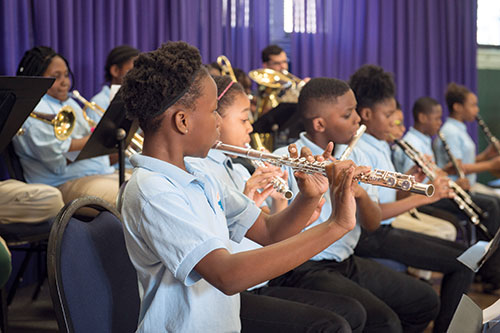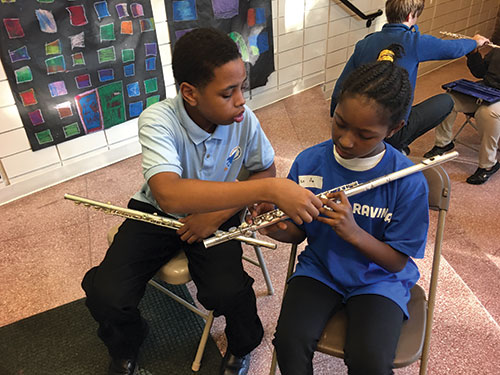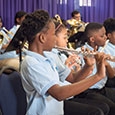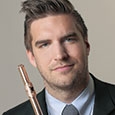For many classically trained musicians in the United States, the phrase El Sistema is either completely unfamiliar or vaguely associated with an alternative music education curriculum. Those more familiar with the program may associate El Sistema with the program’s most famous graduate, Gustavo Dudamel who is the Music Director of the Los Angeles Philharmonic. I was largely unfamiliar with it until I began teaching with a Sistema-style program. As these programs continue to form across the country (and continue to provide employment opportunities for musicians), it is becoming increasingly important to understand what Sistema is, where it comes from, and how to successfully teach students in these programs.

Flute students in the Sistema Ravinia Orchestra Program. Photo by Patrick Gipson
The Rise of El Sistema
In the 1950s, Venezuela was experiencing an economic boom fueled by the oil industry, which in turn led to an investment in Venezuela’s cultural institutions. However, the professional orchestras were dominated almost entirely by European and North American musicians, making it nearly impossible for the best-trained Venezuelan musicians to find employment following their conservatory education. The story goes that upon graduating from the Caracas conservatory in the early 1970s, a young bassoonist brought his instrument to the courtyard of the conservatory and set it on fire, announcing to the crowd that he would never be able to perform with a symphony in his own country.
It was in this period that Jose Antonio Abreu (1939-2018) began El Sistema in 1975. Abreu, who was an award-winning classical pianist, began simply with a vision of a Venezuelan youth orchestra. Abreu found an empty garage space for rehearsals. The first day only 11 musicians came, but within a month they had over 75 musicians, enough for a full orchestra.
While many musicians were students or recent graduates from the conservatory, some could barely play their instruments. These students improved their instrument technique with assistance from the more advanced players. After four months, the orchestra gave its first public performance, presenting works by Vivaldi, Bach, Mozart, and Tchaikovsky. The concert was well-received, and the orchestra was immediately invited to perform in Mexico. However, it was an uphill battle to gain recognition from the established classical organizations in Venezuela who doubted the value of an orchestra that allowed anyone to join without audition and where players learned during rehearsals with guidance from other players.
In 1976, less than a year after their first rehearsal, Abreu brought his orchestra to the International Festival of Youth Orchestras in Aberdeen, Scotland under the name “Orquestra Nacional Juvenil de Venezuela.” This was the first time that a Latin American country was represented at the festival which featured the best youth orchestras from across Europe and North America. The Venezuelan orchestra was highly successful, and their musicians won most of the principal chairs in the festival orchestra. They also had more players in the festival orchestra than any other country.
When they returned to Venezuela, President Carlos Andres Perez met with Abreu and agreed to fully support the project. Abreu chose to establish program under the Ministry of Youth as a social change program focusing on youth especially in middle- and lower-class areas, rather than as an artistic program for the elite under the Ministry of Culture. This was the birth of El Sistema: a publicly-funded musical education program in Venezuela, free for everyone. The program continues to grow every year and currently includes over 500,000 students with plans to grow to over a million students.
El Sistema Today
The current program in Venezuela has over 400 nucleo campuses throughout the country. Toddlers begin with classes that focus on rhythm, expression, and movement. At the age of five, students start on their first instruments (usually recorder and percussion) and also begin choir. By age seven, students can begin learning to play orchestral instruments. There is a national curriculum and teaching sequence, but within that, each nucleo campus is given freedom to make adaptations in order to best serve their local community. At every level community and family involvement is central, and performances occur frequently.
Instruction is always group based, so music learning is a social and interactive experience. Key to the program’s social aspect is that it is free and open to everyone. No student has to pay for instruments, music, supplies, or instruction. The success of the program in terms of social development has been quantified by the Inter-American Development Bank. In calculating falloff in school dropout rates and decline in crime, the bank determined that for every dollar invested into the program the country of Venezuela has reaped about $1.68 in social dividends.
Sistema in the USA
Bolstered by Abreu receiving the Ted prize in 2009, it did not take long for El Sistema to gain international recognition, and currently programs modeled after El Sistema are developing across the globe. In the United States, the allure of El Sistema is understandable. Educators are drawn to this effective model of music education, for the most under-represented students with the least access, when funding for arts education is often hard to find. Similarly, performance institutions hope to invigorate a new generation of classical music enthusiasts at a time when even prominent orchestras are struggling to attract audiences.
Currently there are over 120 Sistema-based programs in the United States. Each one operates independently and varies significantly in terms of level of funding, number of instructors, age groups taught, instruments offered, curriculum, and communities in which they function. They are all linked by a set of ten guiding principles: To Play and To Strive, Access and Excellence, The Nucleo Environment, Intensity, The Use of Ensemble, CATS (Citizen/Artist/Teacher/
Teaching in Sistema
Sistema-style programs in the U.S. vary greatly but generally all include an element of group learning. I teach in a nucleo with Sistema Ravinia, a signature program of Ravinia’s REACH*TEACH*PLAY education programs that fosters youth empowerment and social development through exceptional ensemble training. There are three orchestras for students from fourth through eighth grade. Students work for two hours, every week day following school, and they meet for three hours each day during the summer with focus on their individual instruments through sectional classes and large ensembles. The experience of working with students in large group classes is different from traditional classroom teaching and private studio teaching.
Unlike a school class setting, students are not graded and participation is voluntary. While there are repercussions for poor behavior, harsher forms of punishment such as suspension and expulsion are avoided outside of extreme cases. (In addition to music, the program also has social goals such as helping students, including those who might have behavior issues) Unlike private studios, the abilities, maturity levels, goals, and desires of students in a single class often vary widely. Therefore, lessons are carefully planned to engage students at multiple levels without making things frustratingly easy or difficult for any student. Different from traditional settings is that there is not really an expectation to practice outside of program hours given the extensive number of hours (8-10 per week) spent in the program. Older students are permitted to take their instruments home, but with other afterschool activities, homework, and the already heavy time demands of the orchestra program, few do. Thus, lesson plans not only introduce new material but also allow time for each student to practice this material for some level of comprehensive understanding and technical mastery. Below I have included some ideas that I have found successful in my Sistema classrooms, working with both small sectionals and large ensembles.

Get to Know Your Students
This may seem obvious, but when you have a group of young students at the end of a school day, and you need to get them to the restroom, into their seats, and then somehow achieve a musical lesson in the span of an hour or two, it can be easy to forget to talk to them about life outside of music classes.
Some students may not be interested in the pursuit of musical excellence but have entered the program because they want to learn an instrument, love music, or have friends or siblings in the program. Others come because of scholarships or to bolster high school and college applications. Few, if any, enter the program with aspirations of becoming a professional musician or teacher, or even to try for the Chicago Youth Symphony Orchestra, and that is fine. As a result, they may not feel a passion initially for the music they are learning. This is why developing personal relationships is so important. It is much easier to get students invested in your goals if they care about you and see you as a mentor, than it is to develop an intrinsic passion for scales or Bach and Mozart.
In addition, if students believe that you like and respect them, they will return those feelings. This means they are more likely to follow class rules, self-regulate their behavior, and participate in the class. It is not enough to expect these relationships to form as you continue in the program. You must actively plan activities to get to know one another.
Start by learning students’ names. Begin the year with name games. There are many games where students can use their names or facts about themselves that incorporate studies in basic rhythm and tempo. Make a point of greeting students every day by name as they first enter the program and ask them how they are doing. Many days you may get a grunt and shrug, but on others they will engage in a lengthy conversation about their classes, friends, and family. Their responses are a good indicator of how they will act during class that day.
I always encourage journaling before a lesson starts. I usually pose a question or two that may or may not relate to music. They could include: “What did you do this weekend?” “Why did you pick the flute?” “Tell me about someone you look up to?” “Name two things you thought you did well at your last concert and one thing you would like to improve.” Students then share their answers, and I like to practice stage etiquette for presenters and an audience, complete with bows and applause.
As students start to trust you, they will begin to take an interest in things that are important to you. Share with your students how much you love music, who your favorite composers and pieces are, and why you like to teach and perform. Before long you will find students sharing that same enthusiasm for music.
Develop Routine, Structure, and Expectations
Classrooms and private studios generally have stated rules and policies for student behavior. In a Sistema setting, however, the social goals mean that strict punishments are not an effective way to maintain control. Instead, it is better to maintain classroom order through preventive measures, namely careful planning and constant adaptation. Students usually begin acting out when they do not have anything to do (such as during transition times or when a teacher is addressing an individual student). They are bored and not engaged in the lesson, or are frustrated because they are being challenged too much or do not have clear directions.
Develop a daily warm-up routine and curriculum for each class. This allows the students to fall into a routine with a clearly established beginning and end. I begin with overblowing the harmonics followed by scales, and sometimes also incorporate a minute of tonguing for warmups. We then review any large ensemble music. The lesson is completed with sight-reading, chamber music, or solos. If students complete all of this work then they are usually rewarded with free time, a planned game, or time to work on homework or free practice. Even on my students’ worst days we are usually able to get through overblowing and some scales, because they enter class expecting to review all this material. Once this routine is established, breaking the pattern with a game, skipping scales, or talking to one another really feels like a reward.
The routine is the base for lessons, but in order to keep all students engaged there must be a constant evaluation and re-evaluation of the planned activity. Overblowing the harmonic series is a great tone warm up because this is an effective exercise for every level, with beginners starting on just the headjoint. Scales are great because they reinforce music theory, allow students to begin identifying patterns in music, and can be manipulated in an almost infinite amount of ways to cater towards various levels (i.e. different octaves, articulations, rhythmic patterns, etc.).
As a final note, always be sure that the expectations and intent for every activity or instruction are clear. In Sistema programs where large ensemble rehearsals are emphasized, students do not always understand the relevance of sectional work if it does not relate directly to a specific piece they are performing in those ensembles. I remind them that sectionals are a special time to work on flute-specific technique so that they can perform their best in their large ensemble. This is more than just right notes and rhythms but also playing with a good sound and developing reading skills.
When you make an exercise harder for some students to keep them challenged, be sure you tell them that is what you are doing or else they may feel punished or as though they are being unfairly held to a higher standard than the rest of the class. Highlight students who are doing well and compliment their hard work. Similarly, if a student falls behind, be sure to work on the problems with the entire group so that the student does not feel singled out. For instance, if one student is struggling with a passage, have every student play through it with different rhythms. It will help the student improve and provide a challenge for everyone else. Eventually it is fine to move on for the day, even if some problems still exist, for the sake of maintaining morale. This is the sort of evaluation and reevaluation that should occur constantly in even the most well-planned lessons.
Remember that every Sistema-style program is different. For more information visit the webpage for El Sistema USA. There is amazing literature there including Changing Lives by Tricia Tunstall. There is also a free documentary available on YouTube called Tocar y Luchar and a TED Talk by El Sistema’s founder, Jose Antonio Abreu.
After a quick conversation with the nucleo manager, I taught my first flute class. I worked with two students who were part of the El Sistema style orchestra. Student A was a shy girl in fourth grade who had been playing for about a month, and student B was an incredibly outgoing boy in sixth grade who had started at the beginning of the school year. They were working on a piece called Creature Feature, a simple work with all quarter notes and quarter rests in the key of C minor. Nothing was too low or too high, but there was a lot to look at with articulations, accidentals, and stark dynamic contrasts. I only had about 30 minutes with students, including evaluating their level, so after some quick introductions, I jumped right into the music.
They could follow a conductor and seemed to have a good sense of beat. They could also produce a sound fairly consistently, but they had trouble counting rests and reading the music. It was clear that Student B was actually playing by ear, and did not use the music. He was actually quite proud of the fact that he could do this, but it led to frequent errors. Student A was clearly nervous but trying her best. She played very quietly and was still working on some fingerings. Neither one paid any attention to the articulations or dynamics on the page. We worked on the opening phrase which started piano and grew to a forte over about 5 bars, ending with a dramatic accented note. This piece was about character, and if they could capture that, the audience would not care if they occasionally missed one of the flats. I demonstrated how to shape the phrase then conducted them through the passage, while singing along. The kids laughed at my bad jokes, and time flew by. I ended the lesson by summarizing everything we had worked on and congratulating them on all they had accomplished in a short amount of time. I began as the regular flute instructor that summer.
Summer session was a smaller group than the regular school year. Student B was one of my two flute students. He was incredibly excited to see me and have me play next to him in orchestra. He was still figuring out music by ear, so he picked up things quickly when I played alongside him. We worked hard on reading music and learning correct fingerings in private sessions. He naturally had a great sound, and I started him on overtones to help him control octaves. He had a short attention span, and often seemed more interested in talking than playing the flute, but it was clear he loved music. When he got through lessons, I would reward him by playing basketball with him outside. The school did not have a basketball hoop on their playlot, so the children play, half-court style, shooting the ball between monkey bars. It was like a hybrid of basketball and plinko. He once told me that he wanted to be a professional basketball player or a professional flutist. I think it was the biggest compliment that he could have given me.
Student A rejoined in the fall. That class had four flute students. She was definitely the weakest player and the newest to orchestra. She had forgotten many fingerings and notes over summer break. She had a friend in the class who often helped her with fingerings and finding her place in the music if she got lost. Her biggest problem was confidence, but she worked harder than anyone else and continued through the entire program until graduation. Eventually she became the student I asked when I needed assistance in the classroom or wanted information about other students in the program (why another student was being standoffish or having a rough day). She always played second chair to her friend (it was a comfortable position for her), but I found other ways to help her stand out. I let her use my old student piccolo, and she took to it quickly. I let all of the students try it, but she was the only one who could get a sound. This increased her confidence immediately. She was the only student who chose to continue in high school, which required an audition.
Working on the audition material was hard for her, and there were a few lessons when tears would start rolling down her cheeks as she struggled through a difficult passage. A couple times she told me she hated music, and I always reminded her that she did not have to audition for high orchestra. I almost expected her to give up as others had, but she persevered and gained entrance into the music program at every high school she applied for and ultimately chose to attend a private school that had given her a nearly full scholarship because of her audition.
She still visits the program occasionally. On her first visit back after entering high school, she stood up in front of the entire program and described what it was like being in high school and how we set her up for success. She talked to the eighth grade students about how hard the auditions were and that they were going to feel like giving up, but that they shouldn’t. She said that they should keep working at it even if their friends gave up or encouraged them to quit. I could not believe how the shy girl from my first day had grown into such a confident young woman. She is involved now with every music group she can and hopes to study music education in college.
Unfortunately, not every student is a success story. Student B was kicked out of the program after leaving school grounds repeatedly when he should have been at orchestra. He had left to run family errands, and I remember him crying in the stairwell when he was not allowed to come back. His absence was chronic, however, and there was nothing we could do. Every time I ran into him in the hallways he gave me a hug or a high five and told me he was still trying to get back into orchestra. Tragically, a couple of years later, I heard that he was killed in a shooting. I am honored to know that, for at least a few years, he had a safe place to come and learn music.






